Food Heritage
Adults
by LearnX Singapore
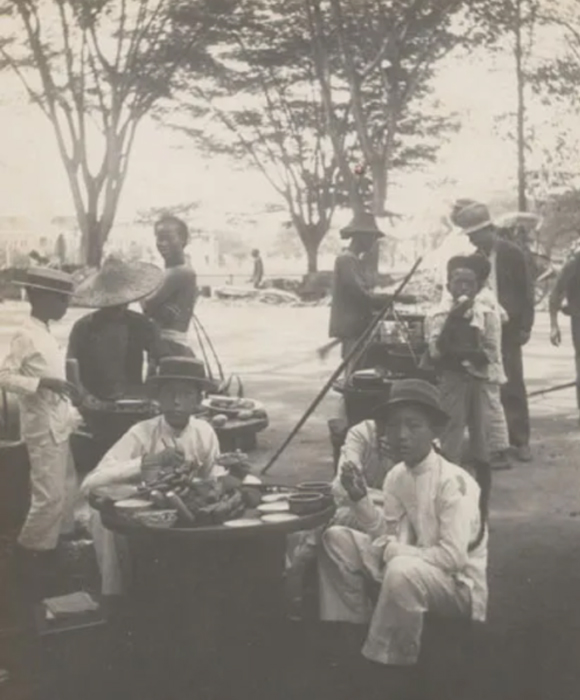
Learn on the go. Check out our playlists for collections of short videos, and learning packages for articles, that will give you a slice of history and heritage.
-
Singapore's Food Heritage: Overview
Playlist
A collection of short videos or selected podcasts, exploring topics around Singapore’s food heritage.
Playlist: Singapore's Food Heritage: Overview
Singapore food continues to evolve over time, enriched by the experiences of our multi-ethnic communities and global food trends.
Check out these resources to find out how others introduce or view Singapore cuisines.
Exploring the cuisine of Singapore | The Culinary Institute of America (36 mins)
Listen to KF Seetoh as he introduces the various common Singapore food from multiple ethnic groups.
Source: Exploring the cuisine of Singapore (2014, Apr 16). The Culinary Institute of America. Retrieved 2022, April 7.
Singaporean food safari - Singaporean Cuisine | SBS Australia (25 mins)
Join Maeve as she introduces Singaporean food through Singaporeans living in Australia.
Source: Singaporean food safari - Singaporean Cuisine (2019, Nov 15). SBS Australia. Retrieved 2022, April 7.
Learning Package: Singapore's Food Heritage: Overview
Singapore’s food heritage mirrors our multi-ethnic culture, characterised with a medley of ingredients and cooking techniques derived from the country’s diverse population.
The evolution of food in Singapore reflects the hopes, longings, and assimilation of early migrants from faraway lands who eventually became residents from our founding years, to the current enthusiastic calls for preserving Singapore’s food heritage as tastes and palates are yet again being shaped by global influences.
Did you know...
Affectionately referred to as the "cooking doyenne", Violet Oon started as a food critic for New Nation in 1974 and went on to become an expert on Peranakan and Singapore cuisines.
These curated set of articles and books give an overview of Singapore’s food heritage.
Articles
Violet Oon is one of Singapore's best known food personalities. She has influenced the Singapore food scene as author, speaker, teacher, consultant and restauranteur.
Source: Violet Oon (2019, April). Singapore Infopedia. Retrieved 2022, April 7
Fast-food chains by Marsita Omar.
Singapore’s love for fast-food began as early as the 1970s, making it one of the popular options among Singaporeans’ dining out culture.
Source: Fast-food chains (2019, May). Singapore Infopedia. Retrieved 2022, April 7
eBook
Singapore cooking: fabulous recipes from Asia's food capital
Tan, Terry, and Tan, Christopher. (2009). Singapore cooking: fabulous recipes from Asia’s food capital. Hong Kong: Tuttle Publishing an imprint of Periplus Edition (HK) Ltd.
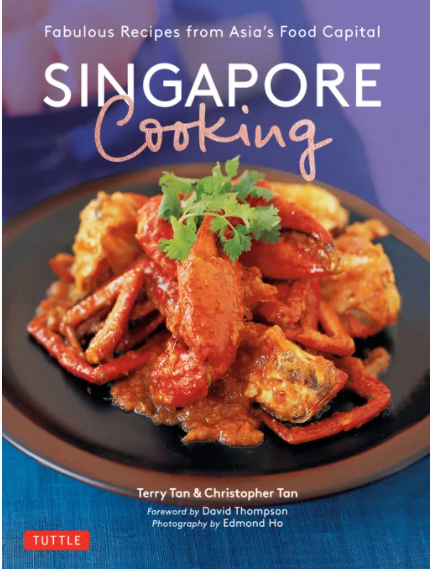
A compendium of popular and less common local classics. With images of common Singapore ingredients and their descriptions.
Retrieved from OverDrive (a myLibrary username is required to access the eBook).
Books
Singapore food: a treasury of more than 200 time-tested recipes
Hutton, Wendy. (2018). Singapore food: a treasury of more than 200 time-tested recipes. Singapore: Marshall Cavendish Cuisine. (Call no.: RSING 641.595957 HUT)
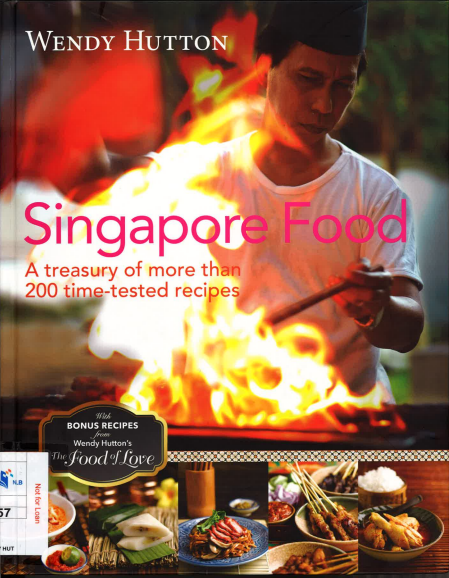
First published in 1979, this updated edition includes 219 best-loved recipes, “new classics” and additional recipes. Also provides an overview of the various multi-ethnic cooking styles.
Singapore heritage food: yesterday's recipes for today's cook
Tan, Sylvia. (2014). Singapore heritage food: yesterday’s recipes for today’s cook. Singapore: Landmark Books Pte Ltd. (Call no.: RSING 641.595957 TAN)
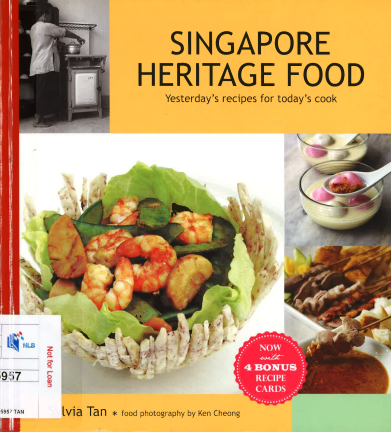
Describes the factors and influences in the unique Singapore culinary heritage and lists the classic dishes and their recipes.
-
Peranakan Cuisine
Playlist
A collection of short videos or selected podcasts, exploring topics around Singapore’s food heritage.
Playlist: Peranakan Cuisine
The term “Peranakan” means “locally born” and is used primarily in insular Southeast Asia to refer to assimilated diasporic groups and hybrid community groups such as the Peranakan Chinese (Baba and Nyonya, or Straits Chinese). Their cuisine may use Malay/Indonesian spices and mainly Chinese cooking techniques.
Check out these resources to help you gain some understanding of Peranakan cuisine in Singapore.
The History of Peranakan Cuisine | VisitSingapore | FT Partner Content (3 mins)
An introductory video to Peranakan cuisine. “This is the origin story of Singapore’s Peranakan cuisine which came into being over centuries as Chinese migrants to the Malay Archipelago (present-day Malaysia, Singapore and Indonesia) intermarried with locals.”
Source: The History of Peranakan Cuisine (2019, Nov 6). VisitSingapore | FT Partner Content. Retrieved 2022, April 20.
Heart of Peranakan cooking with Chef Philip Chia, the Peranakan Chef | ShatecSG Official (3 mins)
Chef Philip Chia shares his passion for cooking Peranakan food and possible future for the Peranakan cuisine.
Source: Heart of Peranakan cooking with Chef Philip Chia, the Peranakan Chef (2020, Mar 9). ShatecSG Official. Retrieved 2022, April 20.
Incredible Peranakan food in Singapore | Mark Wiens (13 mins)
Follow famous food blogger Mark Wiens as he samples several popular peranakan dishes at a restaurant.
Source: Incredible Peranakan food in Singapore (2016, Mar 6). Mark Wiens. Retrieved 2022, April 20.
Learning Package: Peranakan Cuisine
Ayam Buah Keluak, Babi Pong Teh, Ngoh Hiang, Kueh Pie Tee, and Laksa are just some of the beloved dishes that come into mind when one thinks about Peranakan Chinese food. These dishes, which were created in insular Southeast Asia and uses local ingredients, may incorporate Chinese cooking techniques, for example. Some Peranakan dishes were also inspired by trade goods available from the Portuguese, British, and Dutch, such as kueh lapis legit and pineapple tarts.
Did you know...
Peranakan restaurants began appearing in Singapore in the 1970s? The Kolek restaurant at Shenton Way and the Guan Hoe Soon restaurant at Joo Chiat Road in Katong were some of the early pioneers.
These curated set of articles and books will give you a better understanding of Peranakan food in Singapore.
Articles
The Evolution of Straits-Born Cuisine by Lee Geok Boi.
Lee Geok Boi looks at what makes Peranakan cuisine unique and delves into old cookbooks to see how Straits-born cuisine came to be. She discusses how although the Y.W.C.A. of Malaya Cookery Book (1931) -- one of the earliest local cookbooks -- had Straits Chinese recipes, the first local cookbook that identified itself as being a Peranakan cookbook was Mrs Lee's Cookbook (1974) by Mrs Lee Chin Koon.
Source: Lee Geok Boi, The Evolution of Straits-born Cuisine (2021, July-September).BiblioAsia 17(2). Retrieved 2022, April 10.
Forgotten Foods & Mealtime Memories by Tan, Sylvia.
It is important to remember that food and tastes change over time. In this article, food writer Sylvia Tan “remembers the foods and flavours she grew up with and the less than sanitary practices made for the stomachs cast in iron.” The article has a section that discusses how Peranakan Chinese dishes that had perut kambing (goat’s stomach) and a Eurasian dish called feng (pig’s lung) that disappeared as the ingredients were no longer sold in wet markets.
Source: Tan, Sylvia, Forgotten Foods & Mealtime Memories (2016, July-September).BiblioAsia 12(2). Retrieved 2022, April 20.
eBook
In A Straits-Born Kitchen
Lee, Geok Boi. (2021). In A Straits-Born Kitchen.Singapore: Marshall Cavendish Cuisine.

Lee uses the wider definition of Peranakan to mean Straits born in her introductory chapter, including not only the Straits Chinese, but also Eurasian, Chetti Melakan, Indonesian Chinese, Malay and Indonesian recipes. The book is organized according to the basics; kerabu, acar, and vegetables; seafood; meats; light bites and sweet treats. It also has a select glossary of ingredients, a short bibliography, as well as weights and measurements.
Retrieved from OverDrive (a myLibrary username is required to access the eBook).
Books
Food and Foodways in Asia: Resource, Tradition and Cooking
Cheung, Sidney C. H. and Tan Chee-Beng (eds.) (2007). Food and Foodways in Asia: Resource, Tradition and Cooking. London: Routledge. (Call no.: RSEA 394.12095 FOO)
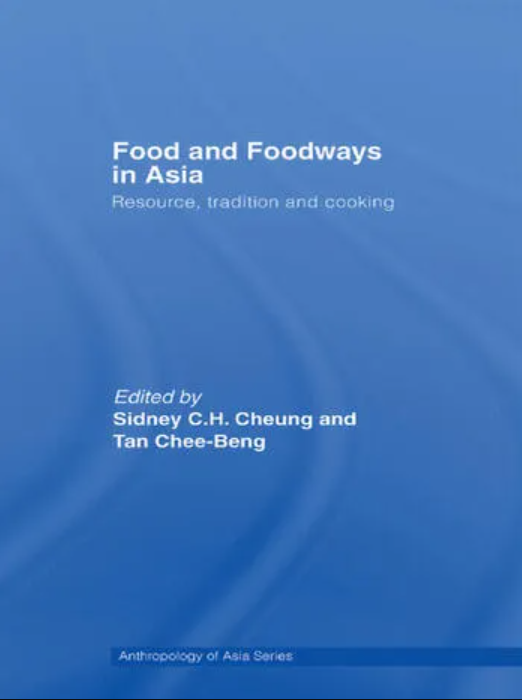
Food and Foodways in Asia provides rich ethnographic description and analysis of food production as it interacts with social and political complexities in Asia’s diverse cultures. The book has two relevant chapters on the Peranakan: Tan Chee-Beng’s “Nyonya cuisine: Chinese, non-Chinese and the making of a famous cuisine in Southeast Asia” and Wong Hong Suen’s “Historically themed restaurants and social memory in Singapore.”
Changing Chinese Foodways in Asia
Wu, David Y. H. and Tan Chee Beng (eds.) (2001). Changing Chinese Foodways in Asia Hong Kong: The Chinese United Nations Press. (Call no.: RSING 641.300951 CHA)
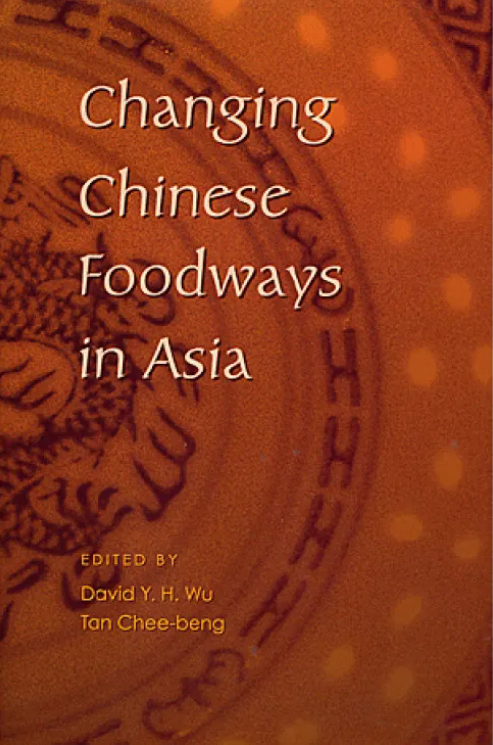
This book has two relevant contributions for Peranakan food, one by Tan Chee Beng entitled, “Food and Ethnicity with Reference to the Chinese in Malaysia” and another by Chua Beng Huat and Ananda Rajah entitled, “Hybridity, Ethnicity and Food in Singapore.”
The New Mrs Lee’s Cookbook Volume 1: Peranakan Cuisine
Lee, Chin Koon and Shermay Lee (2019). The New Mrs Lee’s Cookbook Volume 1: Peranakan Cuisine. Singapore: World Scientific Lifestyle. (Call no.: RSING 641.595957 LEE)
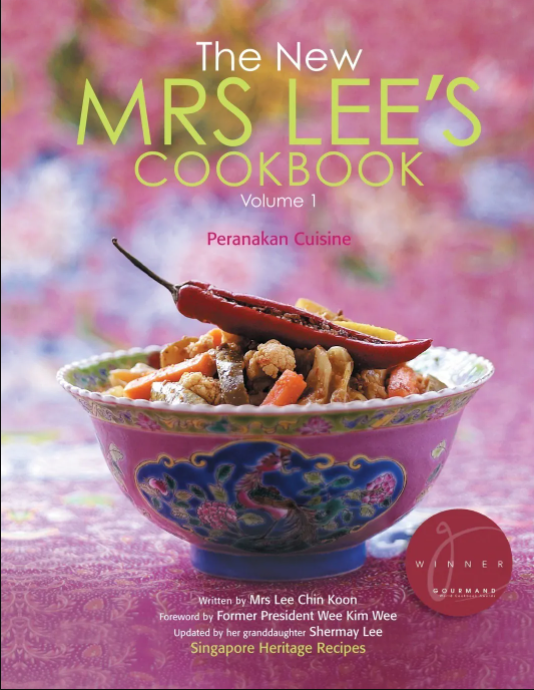
This cookbook was originally published in 1974 as Mrs Lee’s Cookbook by Mrs. Lee Chin Koon, who was Prime Minister’s Lee Kuan Yew’s mother. This was the first self-identified Peranakan cookbook published in Singapore. As the originals became out of print, the cookbooks were updated by her granddaughter, Ms. Shermay Lee, and this revised volume won the prestigious Gourmand World Cookbook Awards in 2003. This book has a foreword by former president Wee Kim Wee. It includes a collection of “classic” Nyonya recipes taught by Mrs. Lee Chin Koon’s mother in preparation for marriage (eg: Ayam Buah Keluak, Garam Masam, and Mee Siam); a list of key peranakan ingredients to start a peranakan kitchen; tips on how to entertain the peranakan way; tips on healthier versions of Peranakan dishes; and a comprehensive glossary of ingredients and basic kitchen equipment required.
-
Eurasian Cuisine
Playlist
A collection of short videos or selected podcasts, exploring topics around Singapore’s food heritage.
Playlist: Eurasian Cuisine
Today, the term ‘Eurasian’ refers to a person with mixed European and Asian lineage. The Eurasians have been present in Singapore since the early 19th century. Most Eurasians in Singapore can trace their European ancestry to the Portuguese, Dutch or British. Their mixed cultural heritage is also reflected in their cuisine which blends European and Asian ingredients and cooking styles.
Check out these resources to learn more about Eurasian culinary heritage and traditions.
Where Did Eurasian Food Come From? | Our Grandfather Story (3 mins)
"Chef and cookbook author, Mary Gomes, talks about the cultures that influence Eurasian cuisine.
Source:Where Did Eurasian Food Come From? (2019, December 18). Our Grandfather Story. Retrieved 2022, May 9.
Eurasian Sugee Cake & Devil Curry | Christmas Recipes With the Drysdales | Our Grandfather Story (8 mins)
Mother and son, Carol and Kurt Drysdale, share their family recipes for Eurasian sugee cake and curry debal which are traditionally served at festive occasions like Christmas.
Source: Eurasian Sugee Cake & Devil Curry | Christmas Recipes With the Drysdales (2020, December 25). Our Grandfather Story. Retrieved 2022, May 9.
Eurasian Putugal | Vanishing Home Recipes | CNA Insider (2 mins)
A group of young Eurasians makes a lesser-known Eurasian dish called putugal (steamed tapioca with coconut and banana).
Source: Eurasian Putugal | Vanishing Home Recipes | CNA Insider (2017, June 13). CNA Insider. Retrieved 2022, May 9.
Learning Package: Eurasian Cuisine
Eurasian food has a history that goes back to the 16th century. Eurasian families emerged from various trading ports in the region, such as Malacca, Penang, Goa, Macau, Ceylon and Bencoolen, where Europeans settled and had children with local women. Many of these Eurasians would later settle in Singapore at different times. Their cuisine blends European and Asian ingredients and techniques. Learn more about the rich heritage of Eurasian food from these books below.
eBooks
Robin’s Eurasian recipes
Pereira, Robin and Quentin Pereira. (2009). Robin’s Eurasian recipes. Singapore: Epigram Books.
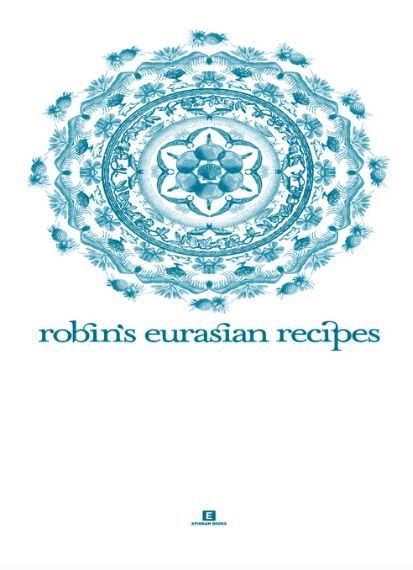
Chef Quentin Pereira shares his father’s well-guarded family recipes. These recipes were passed down from his grandmother, who together with her sisters, used to cook for Eurasian weddings.
Retrieved from OverDrive (a myLibrary username is required to access the eBook).
Eurasian heritage cooking
Pereira, Quentin. (2012). Eurasian heritage cooking. Singapore; London: Marshall Cavendish Cuisine.
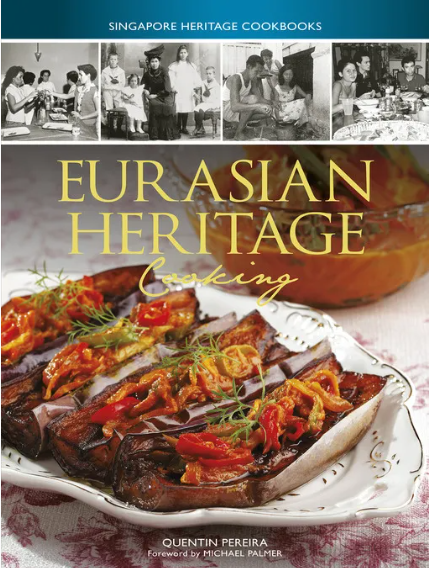
Chef Quentin Pereira is a leading name in Eurasian cuisine in Singapore. He has put together this book to preserve the Eurasian heritage, culture, and recipes for future generations.
Retrieved from OverDrive (a myLibrary username is required to access the eBook).
Books
The Eurasian cookbook
Gomes, Mary. (2001). The Eurasian cookbook. Singapore: Horizon Books. (Call no.: RSING q641.5 GOM)

Mary Gomes shares recipes from her family and friends. This collection of recipes represents the rich heritage of Eurasian cuisine which has been influenced by various cultures like those of the Portuguese, Dutch, English, Chinese, Malay, Indian and Peranakan.
Eurasian favourites
Hutton, Wendy. (2003). Eurasian favourites. Hong Kong: Periplus Editions. (Call no.: RSING 641.5 HUT)

Wendy Hutton presents a selection of recipes that reflects the blending of East and West which is integral to Eurasian cuisine.
The Eurasian table
Noronha, Theresa and Cheryl Noronha. (2015). The Eurasian table. Singapore: Blurb. (Call no.: RSING 641.595957 NOR)
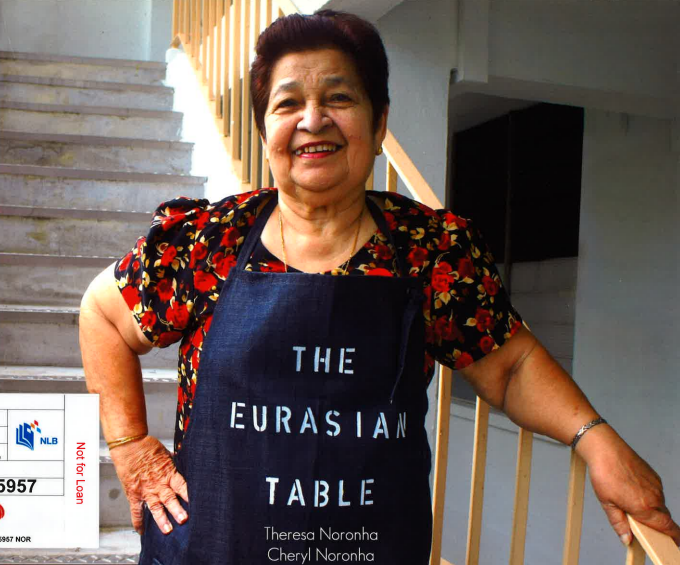
Third-generation Eurasian, Cheryl Noronha, wrote this book to gather and share her grandmother’s recipes of Eurasian dishes. This book features twenty-four traditional Eurasian recipes that are rooted in Portuguese, Indian and Malay cuisines.
-
Chinese Cuisine
Playlist
A collection of short videos or selected podcasts, exploring topics around Singapore’s food heritage.
Playlist: Chinese Cuisine
Singapore’s early Chinese migrants arrived from the southern Chinese provinces of Guangzhou and Fujian. They brought with them two of the most well-known and popular Chinese cuisines, each with its own character, ingredients, cooking methods and tastes.
Check out these resources to learn more about them.
Singapore Local Food - Soon Soon Chinese Teochew Porridge Restaurant! | Mark Wiens (8 mins)
Teochew porridge is a rice porridge dish that is served with various small plates of side dishes. The consistency of the rice is not as creamy and starchy in texture as the Cantonese congee in which the rice grains are broken down much further during the cooking process. Watch Mark Wiens as he sampled Teochew porridge with delectable side dishes.
Source: Singapore Local Food - Soon Soon Chinese Teochew Porridge Restaurant! (2016, March 23). Mark Wiens. Retrieved 2022, May 23.
新加坡,老故事 / Singapore, Old Stories #06: 广东菜 / Cantonese Cuisine | 3Pumpkins (15 mins)
Listen to the presenter share in Teochew about the tales behind popular Cantonese and Teochew cuisines like dim sums, fried dough sticks, congee, and rice noodles. with English subtitles.
Source: 新加坡,老故事 / Singapore, Old Stories #06: 广东菜 / Cantonese Cuisine (2020, July 24). 3Pumpkins. Retrieved 2022, May 23.
Hokkien Braised Mee, but IN HOKKIEN | Sarah and her Mom Cook! (15 mins)
Watch Sarah cook Hokkien braised noodles with her mother, anthropologist Dr Vivienne Wee, as she attempts to converse in Hokkien. With English subtitles.
Source: Hokkien Braised Mee, but IN HOKKIEN | Sarah and her Mom Cook! (2021, February 10). Sarah Huang Benjamin. Retrieved 2022, May 23.
Learning Package: Singapore's Food Heritage: Chinese Cuisine
In Singapore, majority of the early Chinese migrants came from the southern Chinese provinces of Guangzhou and Fujian. Guangdong cuisine like the cantonese, teochew and hakka dishes use steaming, poaching, braising, or simmering to bring out the natural flavour of each ingredient in the dish. Fujian cuisine also has several styles ranging from light, mild sweet and sour taste to more intense flavour with the use of sugar and spices. The Hainanese who arrived in Singapore much later, also brought with them their own special dishes.
Did you know...
Singapore’s popular Hainanese chicken rice is not found in Hainan island. Adapted from the Hainanese dish Wenchang chicken, the rice dish uses Cantonese style of poaching the young and tender-fleshed chicken, and steams rice with chicken-bone stock.
These curated set of articles and books give an overview of Singapore’s Chinese food heritage.
Articles
We are what we eat: the evolution of Chinese food in Singapore by Low Sze Wee.
Author highlights the various popular Chinese dishes and argues how different cultures meet and influence each other resulting in the creation of new Chinese food in Singapore.
Source: Low, Sze Wee. We are what we eat: the evolution of Chinese food in Singapore. (2022, April-June). BiblioAsia 18(1). Retrieved 2022, May 23.
Chinese New Year delicacies by Bonny Tan & Vicky Gao
Discover the common food items found in Singapore Chinese homes during Chinese New Year.
Source: Chinese New Year delicacies. (2018, July). Singapore Infopedia. Retrieved 2022, May 23.
eBooks
Three Dishes One Soup: Inside the Singapore Kitchen
Zhang, Lace. (2019). Three Dishes One Soup: Inside the Singapore Kitchen. Singapore: Marshall Cavendish Cuisine.

It is common to find several dishes served with a bowl of rice and soup in Singapore Chinese families. Author Lace Zhang records her family's recipes with detailed explanations and step-by-step photographs.
Retrieved from OverDrive (a myLibrary username is required to access the eBook).
Uncle Anthony's Hokkien Recipes
Loo, Hock Chye Anthony & Lee, Samantha. (2017). Uncle Anthony’s Hokkien Recipes. Singapore: Epigram Books.
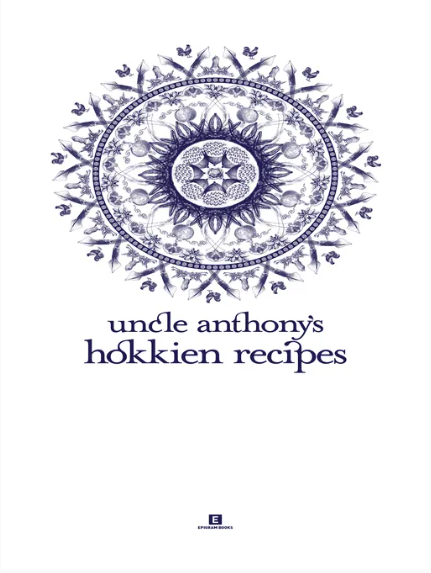
Part of an award-winning Heritage Cookbook series featuring over 80 Hokkien family recipes, including the well-known bak kut teh and lesser-known dishes like the sticky mee sua soup.
Retrieved from OverDrive (a myLibrary username is required to access the eBook).
Uncle Lau's Teochew Recipes
Tan, Lee Leng & Lau, Chiap Khai. (2012). Uncle Lau’s Teochew Recipes. Singapore: Epigram Books.

Features a collection of over 80 time-tested recipes from a Singapore Teochew family. It has common Teochew dishes like steamed fish and ngoh hiang, as well as interesting dishes like Ho Pung and Sio Bee.
Retrieved from OverDrive (a myLibrary username is required to access the eBook).
Madam Choy's Cantonese Recipes
Reutens, Lulin & Choy, Wai Yuen. (2012). Madam Choy’s Cantonese Recipes. Singapore: Epigram Books.

In this third revised edition of part of Epigram Books' award-winning Heritage Cookbook series, it showcases the best of Singapore's Cantonese cuisine from an avid home cook with over 50 years of cooking experience.
Retrieved from OverDrive (a myLibrary username is required to access the eBook).
-
Malay Cuisine
Playlist
A collection of short videos or selected podcasts, exploring topics around Singapore’s food heritage.
Playlist: Malay Cuisine
From nasi lemak to mee rebus, Malay food in Singapore is diverse due to many cultural and culinary influences from the Malay Archipelago and the rest of the world. It incorporates ingredients and cooking methods from various ethnic communities.
Check out these resources to learn more about Malay food heritage and traditions.
The Food That Made Me: Chef Bob & The Wandering People | On The Red Dot | Full Episode (23 min)Chef Bob heads on a culinary journey to learn more about the history of Malay food through traditional dishes including rendang, nasi lemak and ulam.
Source:The Food That Made Me: Chef Bob & The Wandering People | On The Red Dot | Full Episode (2020, March 3). CNA Insider. Retrieved 2022, June 8.
Belongings & Bounty | Yale-NUS College (1 hr 32 min)
Khir Johari, food historian and author of The Food of Singapore Malays: Gastronomic Travels through the Archipelago, explores how the Malays relate to their natural landscape through food. He talks about traditional practice and knowledge of foraging and how foraged items are used in food preparation and medicine.
Source: Belongings & Bounty (2022, April 5). Yale-NUS College. Retrieved 2022, June 8.
[SHF - Heritage Weekend @ MHC] Nasi Tumpeng to Nasi Ambeng: From the altar to the table | Malay Heritage Centre (1 hr 36 min)
Suryakenchana Omar examines the cultural and culinary heritage of nasi ambeng and nasi tumpeng, dishes that are rooted in traditional Javanese rituals. The Javanese are regarded as part of the larger Malay community here. With many restaurants offering different versions of it, nasi ambeng is gaining popularity in Singapore.
Source: [SHF - Heritage Weekend @ MHC] Nasi Tumpeng to Nasi Ambeng: From the altar to the table (2021, May 29). Malay Heritage Centre. Retrieved 2022, June 8.
Learning Package: Singapore's Food Heritage: Malay Cuisine
With many Malays being seafaring people in the past, their diet was typically pescatarian. Malay cuisine has developed to incorporate other ingredients and culinary techniques because of cultural exchanges between the Malay Archipelago and the rest of the world.
Did you know...
Ketupat is rice grains placed in a parcel made traditionally of weaved young coconut leaves and then boiled in water to cook into a compact block of rice. It is often found in Singapore as a celebratory food, served with a variety of dishes. Variations of ketupat can be found in Southeast Asia.
Learn more about the multifaceted heritage of Malay food in Singapore from these articles and books below.
Articles
“Ketupat is a diamond-shaped rice cake. This Malay food staple is made of cooked rice compressed and wrapped in woven coconut leaves. Originating from Indonesia and Malaysia, ketupat is often consumed as an accompaniment to meat dishes such as satay (skewered barbecued meat) or stews, although the traditional version has become less common in Singapore. It is served during special occasions such as Hari Raya Puasa and Malay weddings, but can also be eaten during regular meals.”
Source: Ketupat (2015, October 26). Singapore Infopedia. Retrieved 2022, June8.
“Nasi lemak is a dish made of rice cooked in coconut milk. Aromatics, such as pandan leaves, bay leaves, lemongrass, ginger, garlic and fenugreek, can be added to it. A light meal that is believed to be Malay in origin, it is traditionally accompanied by fried anchovies, sliced cucumbers, fried fish known as ikan selar, and a sweet chili sauce. Modern-day variations on the dish now offer an extensive array of other side dishes.”
Source: Nasi lemak (2010). Singapore Infopedia. Retrieved 2022, June8.
“Rendang is a popular dish made with meat stewed in coconut milk and spices. Commonly found in Malaysia, Singapore and Indonesia, the dish has a long history in the region with distinct versions unique to individual Malaysian states. The different versions of rendang use different ingredients for the rempah (Malay for “spice mix”), thus resulting in differing flavours to the meat.”
Source: Rendang (2010). Singapore Infopedia. Retrieved 2022, June8.
Books
Kuih: from apam to wajik, a pictorial guide to Malay desserts
Hidayah Amin (2020). Kuih: from apam to wajik, a pictorial guide to Malay desserts. Singapore: Helang Books. (Call no.: RSING 641.86 HID)
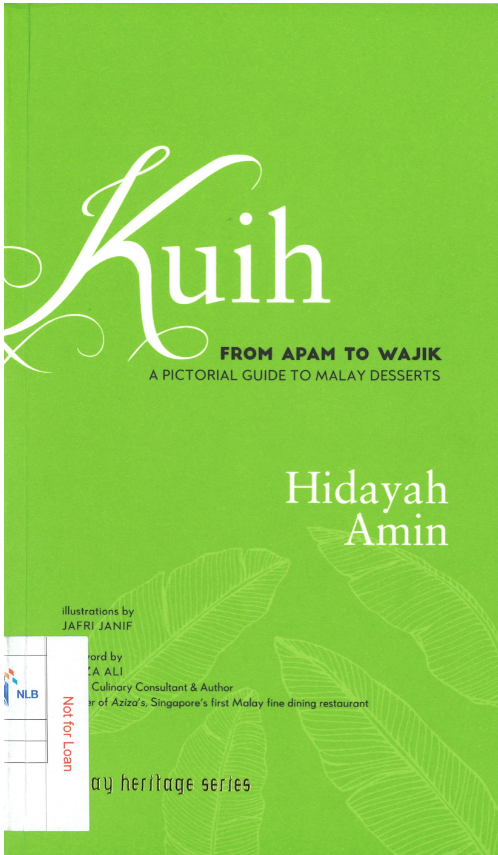
This illustrated guide of 120 Malay desserts showcases the heritage and diversity of Malay food.
The food of Singapore Malays: gastronomic travels through the archipelago
Khir Johari. (2021). The food of Singapore Malays: gastronomic travels through the archipelago. Singapore: Marshall Cavendish Editions. (Call no.: RSING 394.120899928 KHI-[CUS])
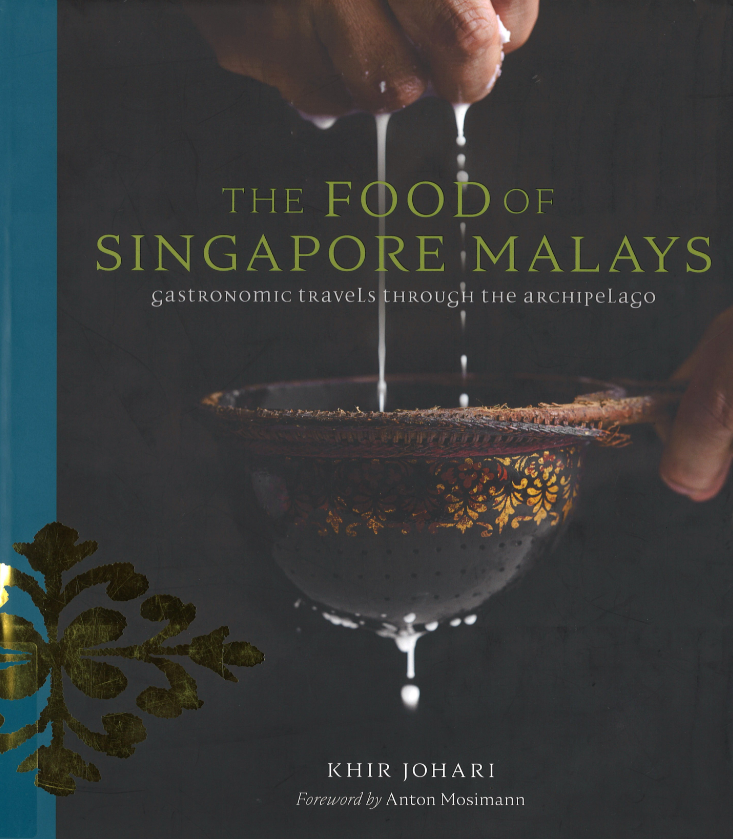
This book explores in detail the history of Malay food in Singapore, looking at how cultural beliefs and geography have shaped the way Malays eat. It also illustrates how Malay cuisine here reflects the diverse origins of its people, who came from different parts of the Malay Archipelago, and the richness of this region. Recipes are included.
Malay heritage cooking
Rita Zahara. (2012). Malay heritage cooking. Singapore: Marshall Cavendish Cuisine. (Call no.: RSING 641.595957 RIT)
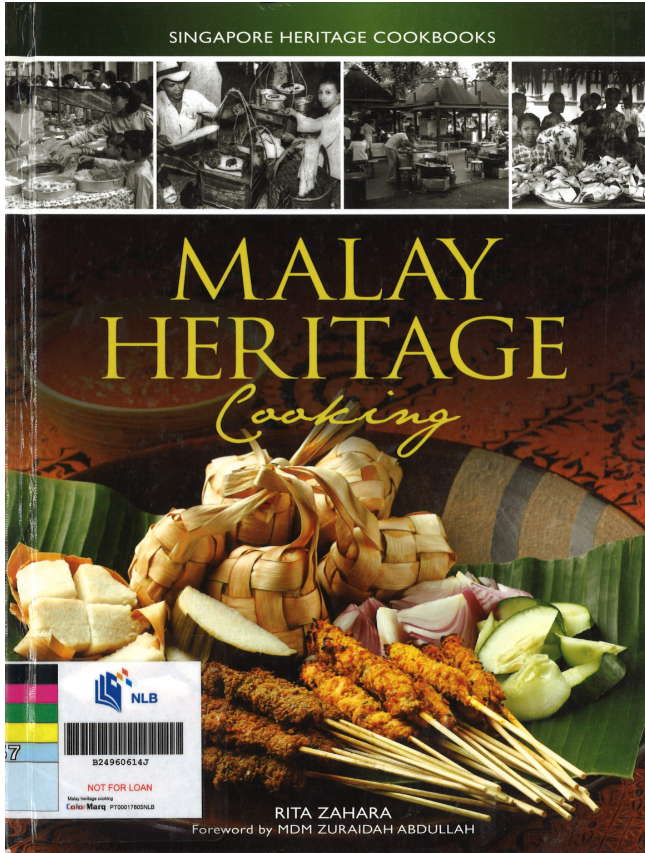
This book provides an overview of the rich heritage of Malay cuisine and the history and culture of the Malays in Singapore. It includes recipes that have been passed down from one generation to another.
The many flavours of Malay cooking
Rita Zahara (2016). The many flavours of Malay cooking. Singapore: Marshall Cavendish Cuisine. (Call no.: RSING 641.59598 RIT)
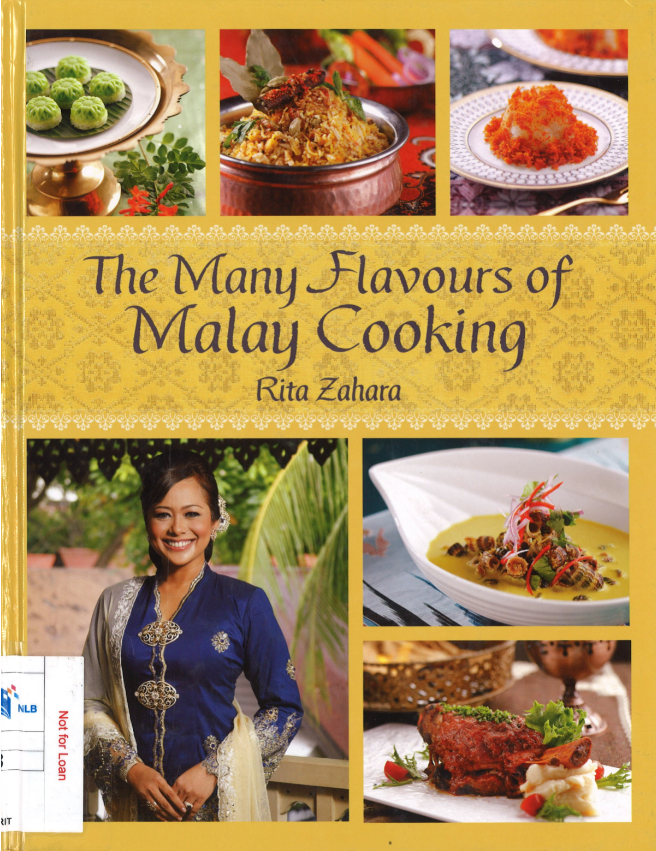
This book showcases the diversity of Malay cuisine in Singapore, featuring a collection of dishes by various ethnic groups that make up the Malay people here. It includes recipes for traditional favourites such as sambal udang, opor daging, and pulut serunding.
-
Indian Cuisine
Playlist
A collection of short videos or selected podcasts, exploring topics around Singapore’s food heritage.
Playlist: Indian Cuisine
Since the commencement of Singapore’s journey as a free port in the early 19th century, the influx of traders and workers from different parts of the Indian sub-continent brought in a variety of cooking styles and recipes to the island. Soon enough, some of these dishes adopted a uniquely Singaporean taste and style.
Check out these resources to help you gain some understanding on both famous and the lesser-known Indian heritage dishes relished by Singaporeans.
The oldest and most authentic South Indian restaurant in Singapore: Samy's Curry | SETHLUI.com (5 mins)
Mr M. Veerasamy was one of the first few cooks to sell fish head curry in Singapore. He started as a roadside stall at Tank Road and eventually settled at a Dempsey Hill restaurant. Listen to the second and third generation owners share their story.
Source: The oldest and most authentic South Indian Restaurant in Singapore: Samy's Curry | SETHLUI.com (2019, July 17). SETHLUI.com. Retrieved 2022, June 21.
Authentic hyderabad biryani in the heart of Singapore: Mr Biryani | SETHLUI.com (4 mins)
Mr Govind, the owner of Mr Biryani, introduces hyderabad biryani, a recipe that originated from the central part of India and compares it with other versions of biryani found in Singapore, which highlights the rich diversity in food varieties among the Indian community on the island.
Source:Authentic hyderabad biryani in the heart of Singapore: Mr Biryani | SETHLUI.com (2019, September 25). SETHLUI.com. Retrieved 2022, June 21.
At this buffet restaurant, you pay as you wish | Our Grandfather Story (4 mins)
Established since 1986, Indian vegetarian restaurant Annalakshmi has served close to 700 recipes originating from different parts of India. Listen to Harish, a third generation staff, explain the rationale behind the 'pay-as-you-wish' policy of this restaurant and the significance of hospitality in the Indian food culture.
Source: At this buffet restaurant, you pay as you wish | Our Grandfather Story (2019, June 20). Our Grandfather Story. Retrieved 2022, June 21.
Learning about Indian breads: thosai, naan, and chapati | MothershipSG (8 mins)
Prata is not the only Indian bread available in Singapore. MothershipSG seeks the expertise of three Indian restaurants to understand some of the other varieties of Indian breads such as thosai from south India, and naan and chapati from north India. It also explores the possible origin of each of these varieties, showing how far across the world these recipes have travelled.
Source:Learning about Indian breads: thosai, naan, and chapati | MothershipSG (2021, May 8). MothershipSG. Retrieved 2022, June 21.
Learning Package: Singapore's Food Heritage: Indian Cuisine
The roots of Indian food heritage lead us back to centuries-old traditions and take us across different parts of the Indian sub-continent region. Just the south Indian dishes in Singapore alone can be attributed to multiple origins such as the states of Tamil Nadu, Kerala, Andhra, Telengana and Karnataka, with each region offering the promise of a different flavour. A common Indian favourite such as curry is not going to taste the same in each of these states. But when all these region-specific recipes met at colonial Singapore, it gave birth to the island’s very own uniquely Singaporean Indian cuisine. The interactions from the Chinese, Malay and European cuisines enhanced its uniqueness even further.
Did you know...
Eating on banana leaves not only make the dishes look more colourful and appealing, it also enhances the taste of the dish. When hot rice is served on the leaf, it absorbs the healthy compounds and unique flavour of the leaf. Banana leaves are waterproof too! Indian dishes, which are mostly accompanied with gravies, chutneys and ghee, are not going to stick to the leaf. This provides us with the fullest dining experience. After the meal, closing the leaf inwards demonstrates a feeling of gratefulness towards the host, so always remember to fold correctly!
These curated set of articles and books will give you a better understanding of Indian food in Singapore.
Articles
Putu mayam, a popular breakfast dish of South Indian origin, is also extremely popular in parts of Southeast Asia such as Singapore, Malaysia and Indonesia. Made from rice flour, this dish can be served with both sweet and savoury sides or dips.
Source: Putu mayam (2020, May). Singapore Infopedia. Retrieved 2022, June 21.
The roots of vadai, a vegetarian South Indian snack, can be traced back the period of ancient Tamils, between 100 BCE and 300 CE. Today, this snack has evolved into various forms, one of which is the Singaporean version of prawn vadai.
Source: Vadai (2014, December). Singapore Infopedia. Retrieved 2022, June 21.
Books
Banana Leaf Temptations
Devagi Sanmugam. (1997). Banana Leaf Temptations. Singapore: VJ Times. (Call no.: RSING 641.5948 SAN)
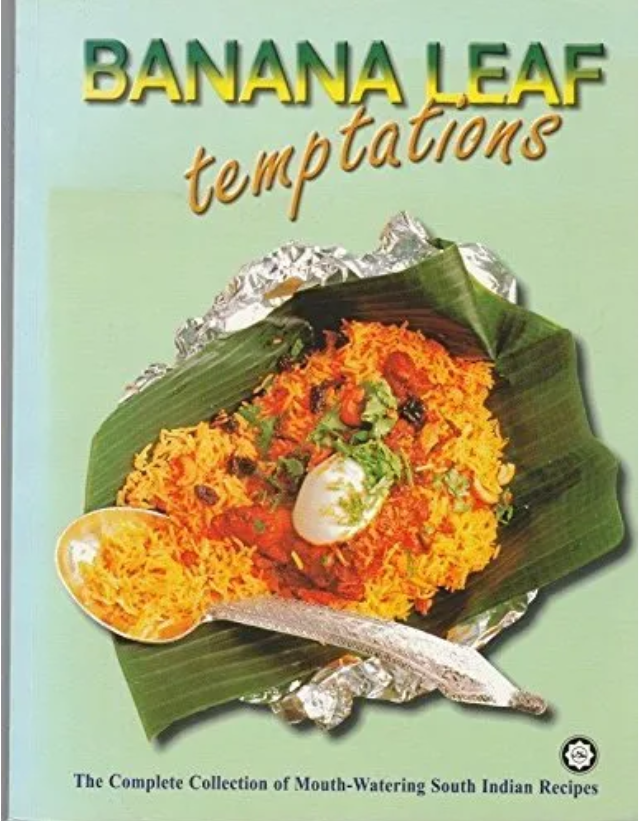
Chef Devagi Sanmugam, known as the Spice Queen in Singapore, shares mouth-watering South Indian recipes that date back to many hundreds of years.
Madam Krishnan’s South Indian Recipes
Krishnan, Ambrose and Krishnan, Padma. (2011). Madam Krishnan’s South Indian Recipes. Singapore: Epigram Books. (Call no.: RSING 641.59548 KRI)

This book is a compilation of the recipes passed down to Padma Krishnan, by her mother and sister-in-law. It presents South Indian recipes with the international touch of France and Mauritius and the Indian touch of Pondicherry and Kerala as well.
Indian Heritage Cooking
Devagi Sanmugam and Shanmugam Kasinathan. (2011). Indian Heritage Cooking. Singapore: Marshall Cavendish Cuisine. (Call no.: RSING 641.595957 DEV)
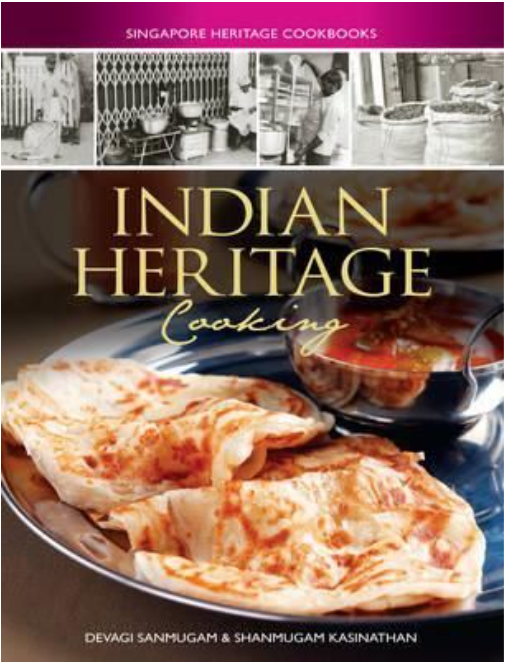
Chef Devagi Sanmugam presents Indian recipes that has gone through fusion amidst the multi-ethnic context of colonial Singapore. She captures the union of flavours from Chinese, Malay and Indian cuisines, which have paved the way to dishes unique to Singapore.
Spice potpourri: stellar cuisine favourites
Rajan, Uma. (2011). Spice potpourri: stellar cuisine favourites. Singapore: E-Quill Media. (Call no.: RSING 641.595957 RAJ)

The winner of the 2012 World Gourmand Best Indian cuisine book, Spice potpourri by Dr Uma Rajan, brings us through a variety of flavourful Singaporean Indian dishes.
-
Hawker Centres
Playlist
A collection of short videos or selected podcasts, exploring topics around Singapore’s food heritage.
Playlist: Hawker Centres
Hawker culture is an integral part of everyday life in Singapore where people of diverse backgrounds gather, mingle, and bond over meals prepared by stall owners at hawker centres. Bringing together the favourite dishes of different ethnic communities, hawker centres and hawker food reflect the multicultural identity of Singapore.
Check out these resources about the evolution of hawker culture and hawker centres in Singapore.
A History Of Singapore Hawker Culture: From Food To Architecture | Hawkers In Our Centre | Part 1/2 | CNA Insider (48 mins)
The first episode in a two-part series on hawker culture in Singapore, this video traces the beginnings, growth, and transformation of the hawker trade against the backdrop of Singapore’s development. It also covers the establishment of hawker centres in the 1970s.
Source: A History Of Singapore Hawker Culture: From Food To Architecture | Hawkers In Our Centre | Part 1/2 | CNA Insider (2020, December 17). CNA. Retrieved 2022, July 7.
Preserving Singapore's Ageing Hawker Culture: The New Wave | Hawkers In Our Centre | Part 2/2 | CNA Insider (48 mins)
The second episode in a two-part series on hawker culture in Singapore, this video looks at the challenges confronting the survival of hawker food heritage and how it continues to evolve with a younger generation at the helm today.
Source: Preserving Singapore's Ageing Hawker Culture: The New Wave | Hawkers In Our Centre | Part 2/2 | CNA Insider (2020, December 17). CNA. Retrieved 2022, July 7.
Learning Package: Singapore's Food Heritage: Hawker Centres
From chicken rice and prata, to nasi lemak and laksa, hawker centres offer a dazzling array of dishes that reflect the multicultural identity and heritage of Singapore. More than just eating places, hawker centres are a unique aspect of Singapore culture and everyday life.
Did you know...
A popular destination for hawker food among locals and tourists, Lau Pa Sat (former Telok Ayer Market) was one of Singapore’s oldest wet markets with a history that dates to the 1820s. The wet market was renovated and turned into a hawker centre in 1972 as its surroundings were redeveloped into a commercial and financial district.
Get to know the history and development of hawker centres and the array of dishes they offer through the resources here.
Articles
Travelling hawkers by Naidu Ratnala Thulaja.
Hawker culture in Singapore had its roots in street food sold by itinerant hawkers during the 19th to mid-20th centuries. While hawkers served the needs of the population, problems such as food contamination and traffic obstruction led to their regulation.
Source: Travelling hawkers (2016). Singapore Infopedia. Retrieved 2022, July 7.
Hawker centres by Tung Ai Jui.
In the interests of public health, the government moved to regulate food hawkers in the 1960s and relocated them from the streets to purpose-built food centres over the 1970s-80s.
Source: Hawker centres (2020, December). Singapore Infopedia. Retrieved 2022, July 7.
eBooks
Food, foodways and foodscapes: culture, community and consumption in post-colonial Singapore
Kong, Lily and Vineeta Sinha (2015). Food, foodways and foodscapes: culture, community and consumption in post-colonial Singapore.Hackensack: World Scientific.
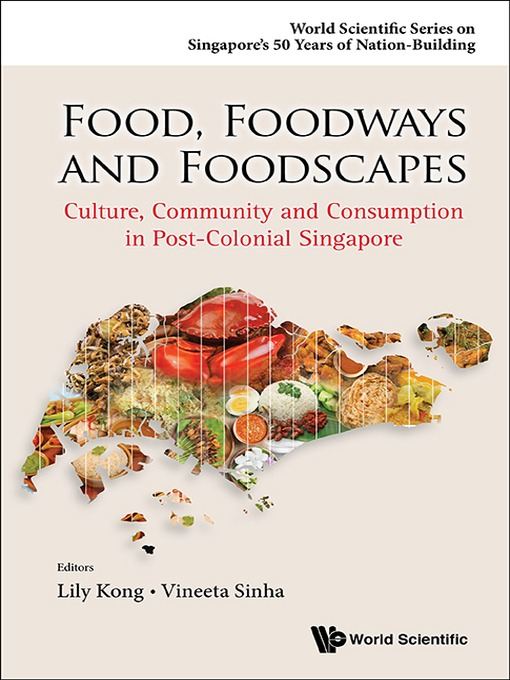
This volume provides multidisciplinary perspectives on the study of food as a window to the social and cultural history and geography of Singapore. Chapter 1, “Taking the Street out of Street Food”, by sociologist Chua Beng Huat offers a biographical account of street food consumption and how it has changed based on life in the neighbourhood of Bukit Ho Swee.
Retrieved from OverDrive (a myLibrary username is required to access the eBook).
Singapore hawker classics unveiled: Decoding 25 favourite dishes
Temasek Polytechnic (2015). Singapore hawker classics unveiled: Decoding 25 favourite dishes.Singapore: Marshall Cavendish Cuisine.
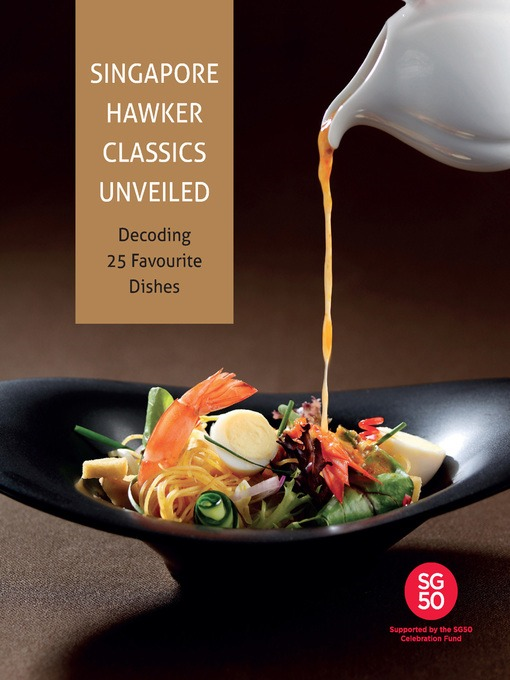
This book covers 25 of Singapore’s favourite hawker dishes, in extensive detail, including information on its heritage, its aroma, taste and texture, its nutritional value, as well as clear step-by-step cooking instructions with photographs.
Retrieved from OverDrive (a myLibrary username is required to access the eBook).
Books
Singapore hawker centres: people, places, food
Kong, Lily. (2007). Singapore hawker centres: people, places, food. Singapore: National Environment Agency. (Call no.: RSING 381.18095957 KON)
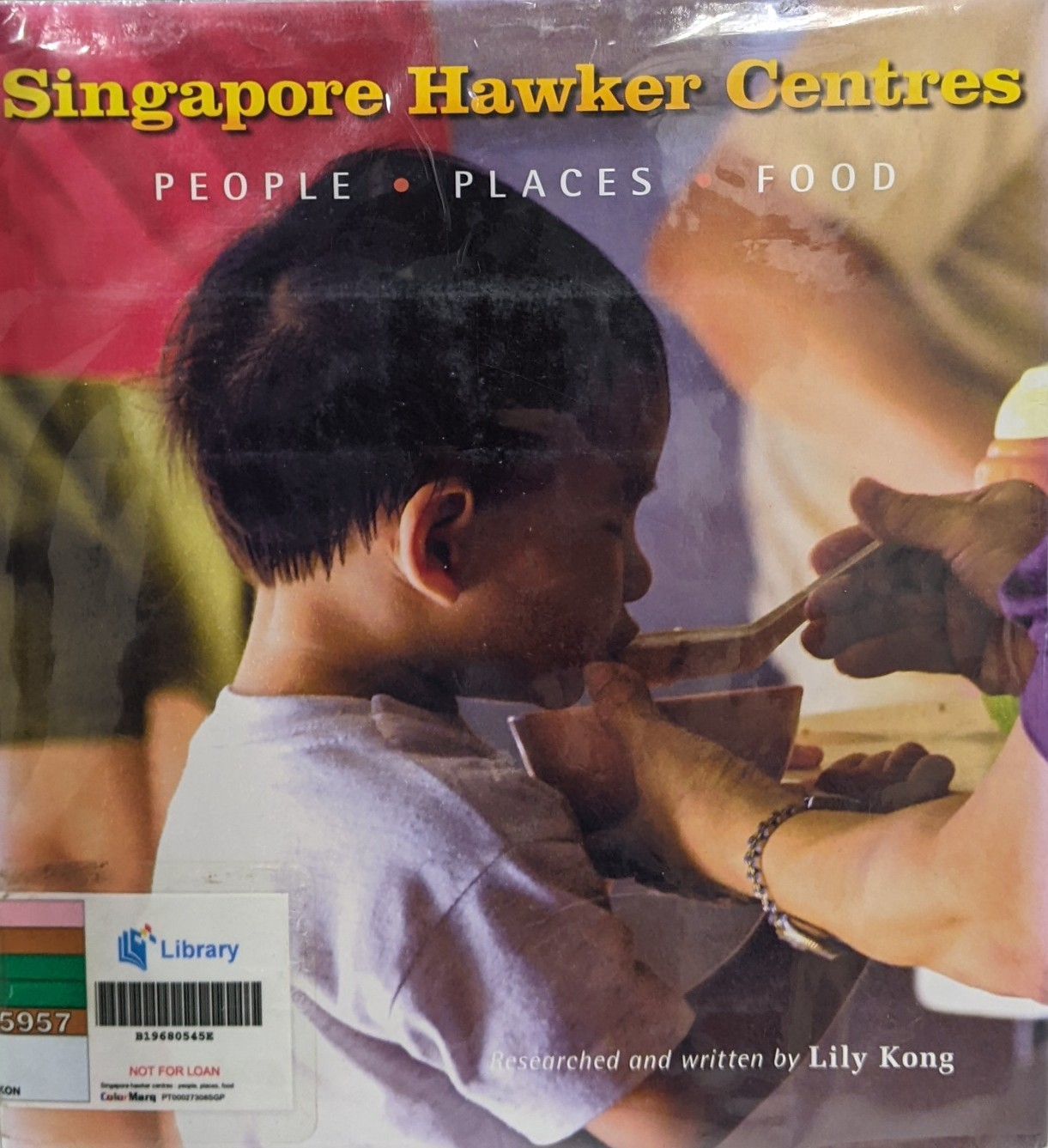
This book chronicles the beginnings and development of hawker centres in Singapore, with a focus on planning and design, and the different stakeholders involved. It also highlights the significance of hawker centres and hawker food to Singaporean life and culture.
Hawker centre food: ambrosia for the people
Lai, Chee Kien & Koh, Hon Teng. (2021). Hawker centre food: ambrosia for the people. Singapore: Achates 360 Pte Ltd. (Call no.: RSING 641.595957 LAI)
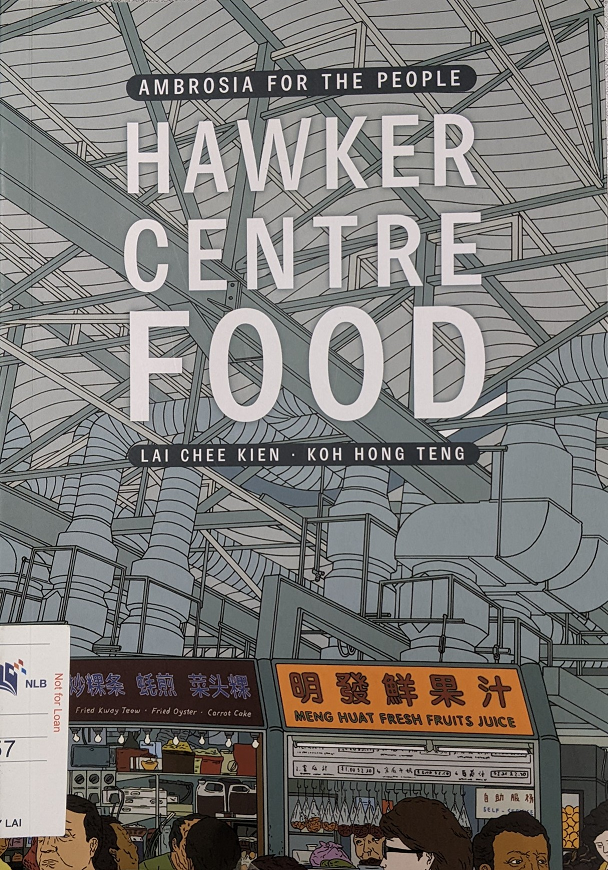
On 16 December 2020, hawker culture in Singapore was officially inscribed on the UNESCO Representative List of the Intangible Cultural Heritage of Humanity
Published in 2021 with support from the National Heritage Board, this book, which features illustrations and stories of 129 food stalls from 111 hawker centres across the island, contributes to the documentation of Singapore’s evolving hawker culture and food heritage.
-
Singapore Food Brands
Playlist
A collection of short videos or selected podcasts, exploring topics around Singapore’s food heritage.
Playlist: Singapore Food Brands
Despite the diverse cultural roots and the multiplicity of food varieties available in Singapore, its people are always brought together through its common food culture, shaped by reputable local food and beverage brands. These brands have found a place in the history of the island, by building a legacy for themselves.
Check out these resources to help you gain some understanding on some of the famous food brands in Singapore.
The People Behind Singapore’s Iconic Soybean Brand | Mr Bean | Our Grandfather Story (5 mins)
Our Grandfather Story explores how Mr Bean transforms 40 000kg of soybeans a month into sweet treats of happiness through its humble recipes.
Source: The People Behind Singapore’s Iconic Soybean Brand | Mr Bean | Our Grandfather Story (2021, December 9). Our Grandfather Story. Retrieved 2022, July 19.
Old Chang Kee: A Taste of Home, Overseas | Enterprise Singapore (2 mins)
Mr Han Keen Juan, the chairman and founder of Old Chang Kee, shares the secret to developing this Singapore’s favourite brand to one that is recognised beyond the borders of the island.
Source: Old Chang Kee: A Taste of Home, Overseas | Enterprise Singapore (2020, May 29). Enterprise Singapore. Retrieved 2022, July 19.
Singapore Pride - Yeo Hiap Seng | MustShareNews (3 mins)
This video traces the story of how a small soya sauce factory in China found its way into Singapore in September 1938, starting off as Yeo Hiap Seng Sauce factory, pushing through war circumstances, developing as a favourite Singapore household beverage brand and establishing itself into an international brand.
Source: Singapore Pride - Yeo Hiap Seng | MustShareNews (2019, April 7). MustShareNews. Retrieved 2022, July 19.
Thye Moh Chan: The Legacy Lives On | MICHELIN Guide Asia (4 mins)
Veteran chef and consultant for Thye Moh Chan, Mr Chua Cha Lai shares how the traditions of making their popular Tau Sar Piah and Teochew mooncakes is kept alive till today.
Source: Thye Moh Chan: The Legacy Lives On | MICHELIN Guide Asia (2018, August 9). MICHELIN Guide Asia. Retrieved 2022, July 19.
How Singapore's Bengawan Solo conquered Southeast Asia | South China Morning Post (5 mins)
Ms Anastasia Liew who grew up in Indonesia and emigrated to Singapore in the 70s, shares on how her passion for baking, paved way for one of Southeast Asia’s most loved brands, Bengawan Solo.
Source: How Singapore's Bengawan Solo conquered Southeast Asia | South China Morning Post | South China Morning Post (2019, June 30). South China Morning Post. Retrieved 2022, July 19.
Learning Package: Singapore's Food Heritage: Singapore Food Brands
Whichever part of the world Singaporeans travel to, the sight of spotting one or two of Singapore’s very own food and beverage brands in a supermart overseas never fail to bring back memories of home. Such heritage food brands have stood the test of time and have also become an integral part of growing up in Singapore. Today, quality products by some of these local brands can be found worldwide.
Did you know....
Peranakan restaurants began appearing in Singapore in the 1970s? The Kolek restaurant at Shenton Way and the Guan Hoe Soon restaurant at Joo Chiat Road in Katong were some of the early pioneers.
These curated set of articles and books will give you a better understanding of heritage food brands in Singapore.
Articles
Bee Cheng Hiang by Hwa Chong Institution.
Most notably known for its signature bakkwa (barbequed pork slices), Bee Cheng Hiang started off its journey on a pushcart in Chinatown in 1933. This article gives an insight into its success story.
Source: Bee Cheng Hiang (2015, May). Singapore Infopedia. Retrieved 2022, July 19.
Khong Guan Biscuit Company by Chua, Alvin.
This article presents Khong Guan, a biscuit company with over 70 years of history that grew from a factory into a multinational business.
Source: Khong Guan Biscuit Company (2016). Singapore Infopedia. Retrieved 2022, July 19.
Books
1883-1983, the great years
Fraser & Neave Ltd. (1983). 1883-1983, the great years. Singapore: Fraser & Neave Ltd. (Call no.: RSING 338.7663 EIG)
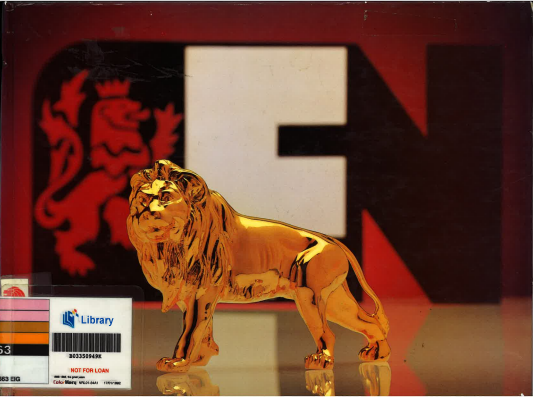
Published to mark the 100th anniversary of Fraser and Neave. This book recounts the history of F&N from the early days in 1883 when it had only a modest operation, to one of the most well-known brand names of the 20th century in Singapore.
Tiger Beer: distinctly Asian, unmistakably world classic
Tai, Jacky (2008). Tiger Beer: distinctly Asian, unmistakably world classic. Singapore: Marshall Cavendish Business. (Call no.: RSING 658.827095957 TAI)
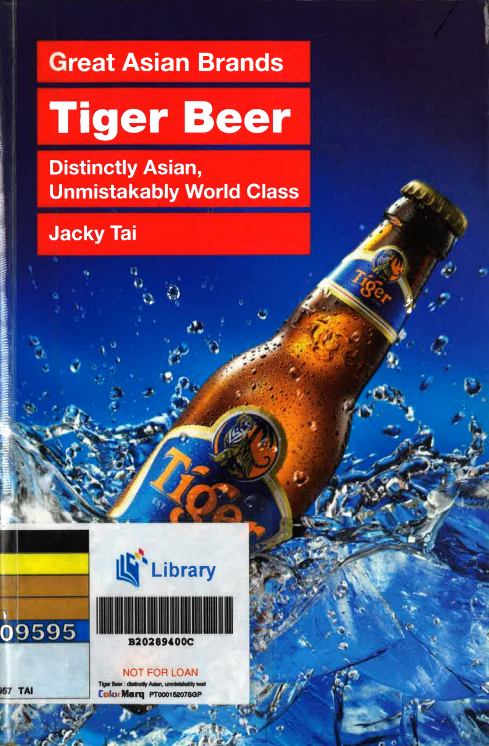
Since its birth in 1932, Tiger Beer is one of a handful of Singapore brands that have made waves internationally. In this book, Jacky Tai explores how this Singapore beer has managed to do so well internationally despite being an Asian brew, as he reveals the secrets of building a strong and consistent brand.
The top toast: Ya Kun and the Singapore breakfast tradition
Koh, William (2015). The top toast: Ya Kun and the Singapore breakfast tradition. Second edition. Singapore: Cengage Learning. (Call no.: RSING 338.76164795 KOH)
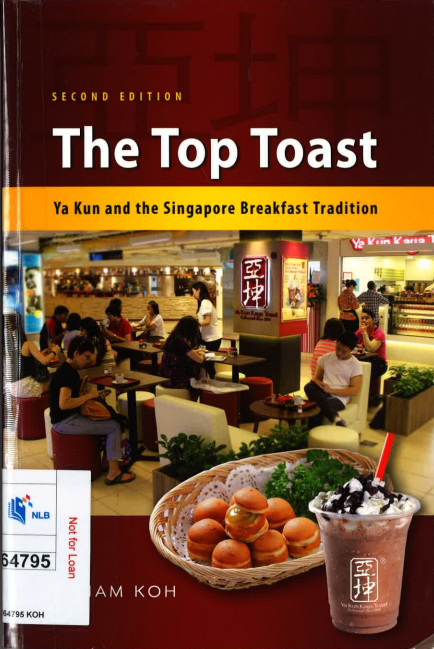
This book traces the humble beginnings of Ya Kun, its reputation for quality toast and coffee, and how it has shaped the breakfast culture of Singaporeans over time.